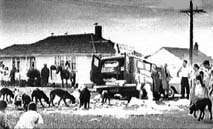
|
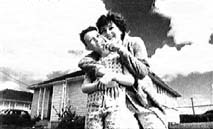
|
RR: I can't help but understand Paul's dream of the dogs eating the pies as the "lost paradise" of the film - in the dream, Paul's mother is happy and radiant, all limits and routines are suspended, there is pure fulfillment - which is why the title of the film gives such special status to the incident. Was this scene present in your original concept of the film?
GN: It was actually very pivotal in the evolution of the screenplay, because what I did was, over a considerable period of time, I accumulated memories and semi-memories, dream-type images... images that had come to me in my dreams. This particular one was a very vivid memory of my own, of an event that actually took place in my own childhood.

|

|
One of the principal things that I was trying to do in the film was to create beautiful moments out of apparently austere environments. And so the dream was something that was really kind of surreal and strange happening in a very commonplace environment.
Does this mean that Avondale Dogs was your working title from the very start?
That's correct. And Avondale is actually where I grew up. You know it's a very autobiographical film.
Are there any major differences between the film in its final form and your initial concept?
Of all the films I've made, it's probably the one that is most like the script. There were a couple of excisions. Not entire scenes, but some scenes were pared down slightly from the original script. Otherwise, the film really reflects quite consistently the screenplay.
The mise-en-scène, shooting and editing of the scene in which Paul kills the pigeon is remarkable. I don't think I've ever seen anything quite like it in any other film. Can you tell me anything about the planning and making of that scene, your intentions in filming and cutting it as you did?
One of the things I wanted to do in fact throughout the whole film was try and capture vividly the subjective experience of the boy and try and identify the audience's emotions with the child and the boy's view of the world. With that particular scene, I decided that I wanted to try and create the impression that the boys in the sweetcorn patch, it was their little jungle, like a vegetable patch Vietnam, if you know what I mean.
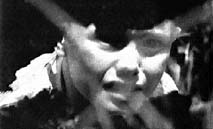
|
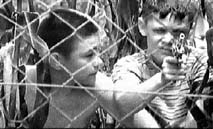
|
And that was one of the scenes where I thought I should get a lot of coverage. And I shot with two cameras. And fairly long-lens shots, quite graphic close-ups and so on to highten the suspense. And there's probably more montage in that scene than anywhere else.
Did you work with a very detailed shooting script?
I tend not to storyboard, generally. I feel that I quite like to work in an organic way and with my collaborators, particularly the director of photography. I've worked a lot with him, and we tend to enjoy working organically on the day. But with this particular scene, because of its complexities, and also the dream sequence with the dogs eating the pies, and also of course the logistical implications of that scene, I storyboarded it quite rigourously. I planned it quite thoroughly, and even though we were shooting with two cameras, we were working to quite a clear, storyboarded cutting sequence.
There is very little dialogue in Avondale Dogs. Do you feel in general, as a matter of æsthetic principle, that a short film should tell its story with as few lines of dialogue as possible?
I suppose it really depends very much on the milieu of the film that you're making. But I think in this particular case, I was wanting to tell a story that was dealing with very universal archetypes. And I tried to work with simplicity and clarity. And I did consciously try to let the images speak for themselves and resonate against each other. I don't know whether I would apply that principle to every short film. But in this particular instance, I thought it was very appropriate.
The acting in Avondale Dogs is superb. Can you tell me about your views on directing actors?
In this case, the boy who plays Paul, Damiel Lay, was a non-actor, had never really acted before on camera. I work quite a lot with non-actors. And in fact, in my feature film, Broken English which I've just completed, I cast a young twenty-two year old Croatian woman who likewise had had absolutely no experience of performance. I tend to cast very very carefully. I find that if I can cast someone who is so like the character in the story, then there's something about their reality, there's something about everything they do that is undeniably truthful, that transcends their being non-actors and actually creates a much more powerful performance.
On the other hand, there are great actors who can do that. I'm not saying I don't work with actors, because I love working with actors. But there is something special about what a non-actor can do, especially in front of a camera, in front of a lens.
Do you want to know more about how I worked with the boy?
Could you tell me more about that please?
Well, basically what I did was I - he's a really remarkable boy, a really gifted boy, I was blessed in that - but what I tend to do is form a very intimate relationship of great trust with my key cast. And I try to make that relationship kind of sacred in the context of the shooting crew. For example, I often shoot - not just in Avondale Dogs but in other films - I work almost with a closed set type environment where there's a minimum number of crew. That kind of sacred relationship between the director and the actors is very... I don't know, there's an intensity there and a trust there, where anything can happen.
For example, if I want to make an adjustment to something that Damien was doing, I would always go to his side and I would whisper to him. I never talk to actors across a room full of people. I always try to talk to them one-on-one and have a very confidential relationship with them. And I think there's something about that approach which makes them feel like there's no one else in the room, apart from me and them. I don't know whether I'm right or wrong but it seems to work.
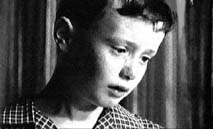
|
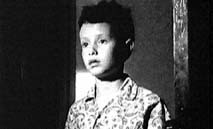
|
There seems to be a hint in the film that Paul's feelings of guilt over shooting the pigeon are somehow linked in his mind to his mother's turn for the worse. That he thinks that his own wrongdoing somehow harmed his mother. Am I wrong in making that connection?
Not at all. No, that was very conscious. And I think it's something that children tend to do. If something's wrong in their life that they don't quite have a grasp of, then they tend to read into their own experiences that somehow they take on a greater significance. They blame themselves.
The introduction to the scene in which Paul steals the toy ring at the dairy bar, sbegins with a shot of power lines or telephone wires. Some of my students suggested that this symbolised the "high tension" in Paul. Is this the way you see that lead in to the scene?
No, I don't really see them as a kind of obvious metaphor, no. I liked the æsthetics of that frame as a way of getting into the scene, and it's also very - for New Zealanders in particular who see the film, it conjures up memories of their own childhood at that time. People who grew up in New Zealand at the time this movie was set, they see it and they immediately have memories flooding back of their own childhood. Ugly power poles by welfare houses with mown lawns and hurricane mesh fences and no trees - I mean it's a very typical New Zealand suburban environment of that era. Other people have said that there's even more significance there, with like the crucifix, but it's really nothing that loaded.
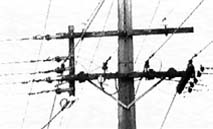
Glenys and Mary have a very close relationship to nature - they raise pigeons, smoke eels, have a horse that isn't just called "the horse" but has a name, Ronny. They are also very kind to Paul and his family and have almost a nurturing relationship to them. Are these positive qualities the attributes of neighbors who just happen to be Maori or are these qualities in any way expressive of Glenys and Mary's ethnic traditions?
That's a complicated question. Certainly, in that time, how that Maori family is depicted is quite accurate. In this welfare housing estate, there was a kind of weird fusion of suburban and rural experience. And Maori families would often be catching eels, and the thing with them smoking the eels in a smoking shed in the back yard was actually very common. And not many white families - we call them pakeha, the Maori word for white is pakeha - not many pakeha families would do that. It's a very Maori thing to do.
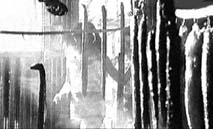
Also, at that time, there was a kind of simplicity in the relationship between Maori and pakeha. And now that relationship is very different. It's much more political since the Maori people as you're probably aware have had a massive renaissance here. There's something about the straightforward honesty and dignity and purity of relationships like the one depicted in Avondale Dogs which aren't really as simple as that any longer. It's much more complicated.
The singing of the Maori lament in the funeral scene brings about a dramatic change in the way people are standing. Dispersed groups of mourners are suddenly reconfigured into a circle with a radiant center: the two women singing. Paul's father was bent over, bowed down as he was being comforted by friends standing around him. When the singing begins, he turns toward the singers and straightens his back. Am I reading too much into this in thinking that the singing reinvigorates the mourners, restores their stamina, has a regenerative power?
That lament, which is called a waiata, is a very, very powerful thing to witness, especially in a small house. Just the power of two women singing that song, it's a spine-tingling sensation you get. It's very intense. That is why the waiata is sung. It is sung for the loved ones of the person who has passed a way, as a gesture of love, basically. Pakeha people react to it in a different way because they don't quite understand it. So it has more solemnity in an environment like the one depicted in Avondale Dogs. For example, if the waiata was sung at a Maori funeral, everybody would be singing, everybody would sing. It's sort of like an honor, it's a great honor for a white person to have a song like that sung in their own home.
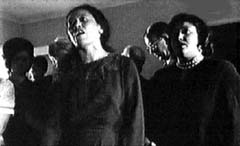
The ring plays a vital role at the end of the story, and marks the bond between Paul and Glenys who become a couple in the final moments of the film. This is done with wonderful restrain and delicacy. The children underact beautifully, Glenys makes no show of emotion. The final two-shot of Paul and Glenys - am I going too far in seeing in it not only the union of two children but also an image of the partnership of the two peoples whose future they represent?
Absolutely. I was trying not to make a heavy-handed statement about that but that was definitely the subtext to it. It was like they were icons of two cultures and the future was ahead of them.
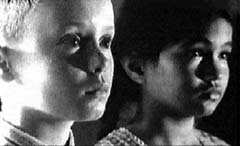
Is there a special charm for you in the short fiction film? Will you be making any more short fiction films, or is your heart now set on making full-length feature films from this point on?
No, not at all. The whole experience of making Avondale Dogs was profoundly illuminating to me about telling stories with film and trying to reach people with stories and touch people's hearts. And quite honestly, it's the only film I have made that has really achieved that successfully.
In some ways, I think the short form is actually a lot harder because you have to tell a story that deals with the kinds of things that happen in Avondale Dogs ... A lot of people said to me: you can't deal with the subject in fifteen minutes, it's just not possible to deal with it in a satisfactory manner. On a couple of occasions, I thought maybe they were right, but I basically decided that I had to do it and I think there's something great about being really concise, and really clear.
I love the short film, but also I have ambitions in the feature length film.
Have any other film makers been a special inspiration for you?
Ozu's Tokyo Story * had a profound impact on me when I saw it. I just loved its absolute simplicity. And the thing that really struck me about the film was its incredible sense of compassion for ordinary people and this is something I tried to bring to Avondale Dogs. And there's also something about the visual style of Ozu and Tokyo Story which influenced me. Just very simple static frames and not a lot of camera movement.
Can you tell me some more about Broken English?
Sure. It's about a Croatian migrant family, particularly a girl named Nina and her relationship with her father, Ivan, who is a very domineering patriarch who exerts incredible control over his family. She falls in love with a Maori boy and they attempt to escape the clutches of her family. She marries a Chinese political refugee for money, to give him permanent residency in New Zealand. And when her father finds out that she's pregnant from a Maori boy and she's married a Chinese guy, things really get out of control. So it's a cross-cultural romance, but the real story is about the relationship between the father and the daughter. And there's this intense love between them, but also this incredible conflict that is generated through the father's prejudices.
This seems to be a very fertile period for filmmaking in New Zealand. Are conditions for filmmaking in New Zealand today more favorable than they have been in the past?
You mean in terms of finance?
Well, I'm just wondering why is it that such creative, original works are coming out of New Zealand right now. Maybe they always were and people in other countries just weren't aware of it. But films like yours and other also feature films are among the most original that are being seen now.
We're a very youthful country, and we're just starting to find ourselves. The films that we're making now have a degree of sophistication and insight into who we are and I think that's what's exciting about what's going on at the moment. There are a lot of emerging younger filmmakers who can tell contemporary stories about our culture now. But tell them with a degree of sophistication, creative sophistication that wouldn't have been possible say eight to ten years ago.
There's this whole flourishing of culture here in all the arts, in popular music and so on. Auckland is quite an interesting place because there's quite a unique ethnic mix here. The most interesting aspect of it is the Polynesian community. We have the biggest Polynesian city in the world. There are massive communities from all over the South Pacific nations here. And they form quite a vibrant presence in the city. So, yes, it's an interesting time.
21 February, 1996
* Tokyo Story (1953) is one of 54 films made by Yasujiro Ozu (1903-1963), whose work is described by Ephraim Katz in the following way: "His style is exquisite in its simplicity. Technically, it is characterized by stationary-camera shots usually taken from a low angle, about three feet above the ground, which corresponds with the eye-level of a Japanese adult crouching on a cushion, a position customarily taken by his tradition-bound characters [...] He seldom varied his camera angle and almost never resorted to such devices as fades, dissolves, pans, or tracking shots. He also ignored the traditional rule of consistent camera direction through 180-degree space [...] he turned out films of great beauty and magnetic power." Film Encyclopedia New York: Macmillan, 1994), p. 1047.